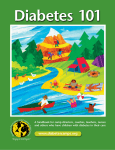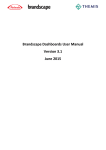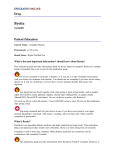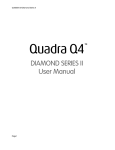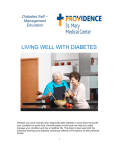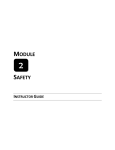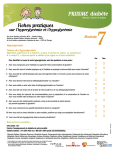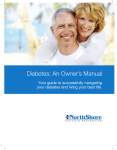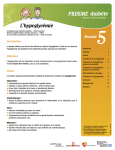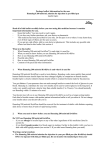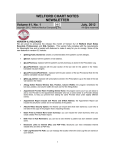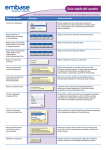Download EDUCATION BOOKLET - Healthy Transitions Colorado
Transcript
DIABETES EDUCATION BOOKLET www.centura.org Centura Health complies with the Civil Rights Act of 1964 and Section 504 of the Rehabilitation Act of 1973, and no person shall be excluded from participation in, be denied benefits of, or otherwise be subjected to discrimination in the provision of any care or service on the grounds of race, religion, color, sex, national origin, sexual preference, ancestry, age, familial status, disability or handicap. Copyright © Centura Health, 2011 What is Diabetes? Taking good care of yourself can seem overwhelming when you have diabetes—whether you’ve just learned you have the disease or you’ve had it for a long time. The right tools and support can make diabetes self-care very manageable in your everyday life. What is diabetes? • When you eat, some of your food is broken down into sugar. Sugar travels in your blood to all your body’s cells. Insulin is a hormone that is made by the beta cells in your pancreas. It works to move sugar from your blood into your cells. • Diabetes means your blood sugar (glucose) is too high because your body is not able to use the sugar for energy. This happens because insulin does not work right. You can think of diabetes as an “insulin problem” and not a “sugar problem”. • When you have type 2 diabetes, your body is not able to use the insulin correctly and your body often doesn’t make enough insulin. When you have type 1 diabetes, your pancreas makes very little or no insulin. When you have diabetes: • Your pancreas makes little or no insulin • Your body prevents the insulin you do make from working right • Sugar can’t get into your cells so it stays in your blood Symptoms of Diabetes The common signs of high blood sugar are: • Feeling tired • Going to the bathroom frequently • Being thirsty more than usual • Being hungry more often than usual • Possible weight loss • Having an infection that does not go away • Having wounds or sores that do not heal well • Numbness or tingling in your hands or feet Some people experience other symptoms. And some people may have no symptoms at all. If type 2 diabetes rarely causes symptoms, why should I care about it? Even though type 2 diabetes may not make you feel sick, it can cause serious problems over time, if it is not treated. The disorder can lead to: • Heart attacks • Strokes • Kidney disease • Vision problems (or even blindness) • Pain or loss of feeling in the hands and feet • The need to have fingers, toes, or other body parts removed (amputated) What is high blood sugar? (also called hyperglycemia) • High blood sugar is a blood sugar level that stays over 250 mg/dl • High blood sugar usually starts slowly • High blood sugar may lead to diabetic coma if not treated What causes high blood sugar? • Eating too much food • Not taking enough diabetes medicine • Having the flu or being sick • Having stress in your life What are symptoms of high blood sugar? How do I treat high blood sugar? 1. Check your blood sugar. 2. Drink 8-10 glasses of water per day. (If you are not on a fluid restriction) 3. If blood sugar stays over 250 mg/dl for 2 days, call your care provider. What is low blood sugar? (also called hypoglycemia) • Low blood sugar is a blood sugar below 70 mg/dl • Low blood sugar can come on very fast • Low blood sugar may lead to coma if not treated What causes low blood sugar? • Not eating enough food • Too much insulin or diabetes pills • Extra exercise or activity What are symptoms of low blood sugar? How do I treat low blood sugar? 1. 2. 3. 4. 5. 6. Take 15 grams of carbohydrates Here are some examples (choose one) • 3-4 glucose tablets • 4-6 ounces regular soda • 4-6 ounces fruit juice • 1 cup skim or 1% milk Wait 15 minutes. Recheck blood sugar (should be above 70 mg/dL) Repeat if blood sugar has not increased. Once your blood sugar returns to normal, eat a meal or snack. This can help keep low blood sugar from coming back. Tell your diabetes care team if you often have low blood sugar. You and your team may need to change your diabetes care plan. How do I manage my diabetes? Whether you have type 1 or type 2 diabetes, managing diabetes is a balancing act. You need to balance: • Food- Eat healthy foods. Avoid foods high in sugar and fat. Do not skip meals. • Exercise- Start slow and work towards getting at least 30 minutes of extra activity at least 4 days each week. Examples of extra activity can be walking, climbing stairs, dancing, mowing grass, or vacuuming. Talk to your care provider before starting an exercise program. Choose activities you enjoy. • Medicines -Take diabetes pills or insulin, if prescribed by your caregiver. • Stress – Learn to problem solve and use healthy coping methods. • Monitor your blood sugar - It is important to check your blood sugars to know how well you are managing your diabetes. Ask your care provider about how often you need to do this. You can also: • Control your weight. If you are too heavy, losing even a few pounds can make a difference. • Stop smoking • Learn as much as you can about diabetes. Attend diabetes classes. Read or view videos from trusted sources. What should my blood sugar be? The general guidelines for your target blood sugar are: • Before meals: 80-120 mg/dl Your goal is: ________ • 2 Hours after meals: Below 160 mg/dl Your goal is: ________ • Before bed: 100-140 mg/dl Your goal is: ________ Why is controlling blood sugar important? • In the short term, it will help you feel better and have more energy • In the long term, it will help prevent problems with eyes, kidneys, nerves, and blood vessels As part of your care plan, be sure to keep track of your ABC’s: A = A1c B = Blood pressure C = Cholesterol My current lab values: Individual Target: A1c _______________ (Less than 7%) ______________ Blood Pressure ______________ _______________ (Less than 130/80) Cholesterol – Total ______________ _______________ (Less than 200) HDL ______________ _______________ LDL ______________ _______________ (Less than 100) (Women greater than 50 Men greater than 40) What is the A1c test? • It is a blood test done in the lab that measures your average blood sugar level for the past 3 months. • It should be checked every 3 to 6 months. • The higher your A1c, the higher your risk for getting complications. • A1c goal should be less than 7%. Knowing both your A1c and your daily blood sugars gives a better total picture of your diabetes control! A1c % Average Blood Sugar mg/dl 13 330 12 300 11 270 10 240 9 210 8 180 7 150 6 120 5 90 4 60 High risk for complications Low risk for complications Normal is 5.7% or below. Aim for an A1c below 7%! Date: My A1c: ___________ ___________ ___________ ___________ ___________ ___________ ___________ ___________ Managing Diabetes AADE7™ Self-Care Behaviors These 7 things can help make sure you stay healthy. You can work with your diabetes care team to decide how to fit them into your daily life. 1. • Healthy Eating Do not skip meals. o Eat when you are hungry. Stop when you feel satisfied. • Eat meals and snacks at regular times every day. o Eat 3 balanced meals a day, plus snacks if you are hungry. o Spread meals out over the day. • Eat a variety of foods. o Add lots of color to meals with fresh fruits and lots of vegetables. o Enjoy plenty of whole grains. o Make sure you get enough fiber every day. • Watch portion sizes. • Slow down and enjoy the flavor of each bite of food. • Limit sweets and regular soda. 2. Being Active • Aim for 30 minutes of non-stop activity each day. • Start slowly if you haven’t exercised for awhile and talk to your doctor about activity guidelines. • Choose activities that you enjoy. 3. Monitor and record your blood sugar levels • Check your blood sugars with your meter every day. • You may check when you wake up in the morning, before you eat, or 2 hours after eating. • Record your blood sugars in a logbook and bring it to all your medical appointments. Instructions for checking your blood sugar: 1. After washing your hands, insert a test strip into your meter. 2. Use your lancing device on the side of your fingertip to get a drop of blood. 3. Gently squeeze or massage your finger until a drop of blood forms. (Required sample sizes vary by meter.) 4. Touch and hold the edge of the test strip to the drop of blood, and wait for the result. 5. Your blood glucose level will appear on the meter’s display. Note: All meters are slightly different, so always refer to your user’s manual for specific instructions. Other tips for checking: • With some meters, you can also use your forearm, thigh, or fleshy part of your hand. • There are spring-loaded lancing devices that make sticking yourself less painful. • If you use your fingertip, stick the side of your fingertip by your fingernail to avoid having sore spots on the frequently used part of your finger. *Call the 800# on the back of your meter for questions / customer service. 4. Take your medications as directed • Know how your medicines work and when you should take them. • Know which medicines can cause blood sugar to drop too low. • Keep a list of all your medications and carry it with you. 5. Reducing Risks • Schedule doctor appointments at least every 3 months. • Follow ‘sick day’ rules when you are feeling sick. • Keep your blood pressure and cholesterol at a healthy level. • Check your feet daily for redness, sores or cuts. o Wash your feet every day and make sure you dry feet & toes well. o Cut toenails straight across regularly (See a foot doctor if you have toenail problems). Reducing Risks continued o Wear comfortable shoes. o Do not go barefoot- always wear shoes that protect your feet and slippers with a hard sole. o Use lotion to keep skin soft but not between your toes. • Visit your eye doctor every year for a dilated eye exam. • Take good care of your skin. o Avoid very hot baths or showers. o Moisturize skin with non-alcohol based lotion. o Treat cuts right away- see your doctor right away if you get a major cut, burn or infection. • Take good care of your teeth. o Brush & floss your teeth and gums every day. o Change your toothbrush every three months. o Have your teeth examined and cleaned every 6 months. o See your dentist if you have unusual pain, swelling or bleeding. • Get a flu shot every year and ask your doctor about a pneumonia vaccine. • Stop smoking. 6. • 7. Problem Solving Know the signs of low (hypoglycemia) and high (hyperglycemia) blood sugar and take action. Healthy Coping • Having diabetes can make you feel discouraged, stressed, or even depressed. Learn healthy coping methods to deal with your feelings. • Get support from your friends, family, or a support group with others who also have diabetes. • Go to education sessions where you can learn more about managing your diabetes. • Set small goals that will help you take steps to being the healthiest you can be. What is a Sick Day? A sick day is when you have a cold, the flu or a fever. Blood sugar tends to go up when you are sick. What should I do if I am sick? • • • • • • Keep taking your diabetes medicines. (Pills and/or Insulin) Check your blood sugar every 4 hours. Check your urine for ketones every 4 hours. (If you have Type1 diabetes) Drink 1 cup of sugar-free liquid every hour (like water, broth, caffeine free diet soda or tea). Eat your usual diet if you can. If you can’t eat your usual diet, choose 1 of these foods or liquids every hour. Sick day foods and liquids*: 1/2 cup regular Jell-O® (not sugar-free) 1/4 cup applesauce (not sugar-free) 6 saltine crackers 1 cup soup 1/2 cup non-fat fruit yogurt (not sugar-free) 3 graham crackers 1 cup sports drink 1/2 cup sugar-free pudding 1 slice toast or bread 1/2 cup regular soda (not sugar-free) 1/4 cup sherbet 1/3 cup cooked rice 1 fruit juice bar (not sugar-free) 1/2 cup ice cream 1/2 cup mashed potatoes 1/2 cup fruit juice 5 vanilla wafers 1/2 cup hot cereal *Each has about 15 grams of carbohydrate When should I call my doctor? • • • • • • You have been sick for 1-2 days, and you are not getting better. You have been throwing up or having severe diarrhea for more than 6 hours. You cannot think clearly, your breathing becomes fast, or you have a fever over 101ºF. Your blood sugar stays over 250 mg/dl on 2 checks 4 hours apart. You have moderate or large amounts of ketones in your urine. (If you have been told to check this) You are not sure what to do to take care of yourself. Medications for Diabetes If you cannot manage your diabetes with diet and exercise you may need medicine. Diabetes medicine can be taken by mouth or injected through the skin. You may be on more than one medicine. You may also be on a medication to keep your cholesterol at a healthy level. Oral Medications Brand Name Generic Name How It Works Side Effects Amaryl glimepiride Stimulates release of insulin from pancreas Low blood sugar; weight gain Glucotrol, Glucotrol XL glipizide Diabeta, Glynase, Micronase glyburide Starlix nateglinide Prandin repaglinide Fortamet, Glucometformin phage, Glucophage XR. Glumetza, Riomet Precose acarbose Glyset miglitol Actos pioglitazone Januvia sitagliptin Onglyza saxagliptin Tradjenta linagliptin Reduces amount of Stomach or intestisugar made by the nal problems; liver may cause lactic acidosis Slows digestion of Stomach or intesticarbohydrates nal problems Helps cells use insulin better Weight gain; liver problems; may cause heart attack Increases release of Headach; upper insulin in response respiratory infection; to a meal sore throat; runny or stuffy nose Some medications for diabetes are combinations of medicines. Brand Name Generic Name ACTOplus met pioglitizone and metformin Glucovance glyburide and metformin Metaglip glipizide and metformin Jentadueto linagliptin and metformin Janumet sitagliptin and metformin Kombiglyze saxagliptin and metformin • • • Because the drugs listed above act in different ways to lower blood glucose levels, they may be used together. Though taking more than one drug can be more costly and can increase the risk of side effects, combining oral medications can improve blood glucose control when taking only a single pill does not have the desired effects. You should know that alcohol and some diabetes pills can interact and cause vomiting, flushing, or sickness. Ask your doctor if you are concerned about any of these side effects. The medication I am taking is: _____________________ ______________________________________________. Insulin What is Insulin? • Insulin is a hormone that is made in the pancreas - an organ in your body. How does it work? • Insulin lowers blood sugar by moving sugar from the blood into the cells of your body. Once inside the cell, sugar provides energy. • Insulin lowers your blood sugar whether you eat or not. You should eat at regular times if you take insulin. Can insulin be taken as a pill? • No. Insulin can only be taken as a shot because insulin would be destroyed in the stomach. What are the types of insulin? Insulin Brand Name = Generic Name When to Use/ How It Works Rapid acting insulin Humalog = insulin Given before you eat; Side Effects Low blood sugar; weight gain lispro; Apidra = insulin glulisine; Novolog = insulin aspart Starts working within 5-15 minutes Short acting insulin Regular Given before you eat; Starts working within 1/2 to 1 hour Low blood sugar; weight gain Intermediate acting insulin NPH Given in the morning or evening; Lasts for 10-20 hours Low blood sugar; weight gain Long acting insulin Lantus = insulin glargine*; Levemir = insulin determir Once or twice a day dosing; Provides coverage over 24 hours Low blood sugar; weight gain Pre-mixed insulins 70/30, 50/50, 75/25 Usually given before breakfast & dinner Low blood sugar; weight gain Other injectable Victoza - Liraglitude Given once a day. Nausea; Vomiting Other injectable Byetta = exenatide Given before morning and evening meals; Helps increase insulin production Nausea; Vomiting Other injectable Symlin = pramlintide acetate Given at mealtime; Used with insulin; Helps lower after-meal blood sugars Low blood sugar; Nausea; Vomiting * Lantus must not be mixed in a syringe with any other insulin. What about insulin safety? • Check the expiration date, and do not use it if it has expired. • An open vial is only good for 30 days. • Look at the bottle and be sure regular insulin is clear. • NPH insulin should be cloudy, but should not be clumped or have floating pieces in it. If it does, do not use it. When should I take insulin? • Try to take insulin at about the same time every day. How should I store insulin? • Most people store their insulin in the refrigerator. The door of the refrigerator is best. • Insulin can be kept at room temperature. If insulin gets too hot or cold, it breaks down and does not work. • Do not keep it in very cold places such as the freezer, or in hot places, such as by a window or in the car’s glove box. Your Action Plan Use this guide to help you report changes to your doctor or other healthcare provider. For most medical problems, you should first call your primary care doctor. Your doctor can answer your questions and guide you to make an appointment if needed. You are doing WELL when: • • • • • You have no symptoms of high or low blood sugar. You are checking your blood sugar levels and they are staying within your target range most of the time. You are eating right, staying active, and maintaining a healthy weight. Your blood pressure and cholesterol are staying within your target range. You are seeing your doctor every 3 months for ongoing checkups. Call your doctor in the NEXT 24 HOURS if: • • • You notice you have a blister, sore, or another abnormality in your feet, and it is getting larger or seems infected. You are not sick and you are taking your medicines but your blood sugar levels seem to have suddenly changed. You have questions or want to know more about diabetes. Call your doctor RIGHT AWAY when: • • • • • • You are sick and your blood sugar stays over 300 mg/dL for more than 24 hours. Do not take over-the-counter medications without first consulting your doctor. You have been throwing up or have severe diarrhea for more than 6 hours. You have moderate or large amounts of ketones in your urine (if you have been told to check this) and they won’t come down after several hours of treatment. If you develop abdominal pain. If you often have problems with high or low blood sugar levels. If you have trouble knowing when your blood sugar is dropping low. Call 911 or other emergency services right away if you are: • • • Unconscious or you suddenly become very sleepy or confused and difficult to awaken. You cannot think clearly, your breathing becomes fast, and you have a high fever that won’t come down. You have a low blood sugar that will not come up after multiple treatments with carbohydrate. The best way to prevent diabetic emergencies is to regularly check your blood sugar levels, take your medications as prescribed, eat well, exercise, learn to cope with your stress, and keep all appointments with health care providers. My Personal Plan I would like to work on the following areas to manage my diabetes: o Healthy Eating o Being Active o Monitoring my blood sugar o Taking medications o Reducing health risks o Problem Solving o Healthy Coping What about this area do you find to be the most challenging? ____________________________________________________________________ ____________________________________________________________________ ____________________________________________________________________ What are 3 things that keep you from making this behavior part of your day-today activities? ____________________________________________________________________ ____________________________________________________________________ ____________________________________________________________________ How can you partner with your doctor to reach this goal? ____________________________________________________________________ ____________________________________________________________________ ____________________________________________________________________ How can you partner with your friends, family and loved ones to reach this goal? ____________________________________________________________________ ____________________________________________________________________ ____________________________________________________________________ My confidence in being able to meet my GOAL: 0 1 2 3 4 5 6 7 8 9 10 Not confident Very confident How can I have the best care for my diabetes? Ask to have these tests done and work to get your results in target range: Test: How often: Target: Blood Pressure Every visit Below 130/80 Weight Every visit Dilated Eye Exam Yearly Complete Foot Exam Yearly Foot Check Every visit A1c Blood Test Every 3 to 6 months Below 7 Cholesterol Blood Yearly Test Total Cholesterol Below 200 Triglycerides Below 150 HDL (Good cholesterol) Over 45 LDL (Bad cholesterol) Below 100 Urine Protein Yearly Flu shot Yearly No protein My Result: Blood Sugar Log Date Sun Mon Tues Wed Thurs Fri Sat Before first meal of the day (Breakfast) Before mid-day meal (Lunch) Before evening meal (Dinner) Before bedtime Comments
























